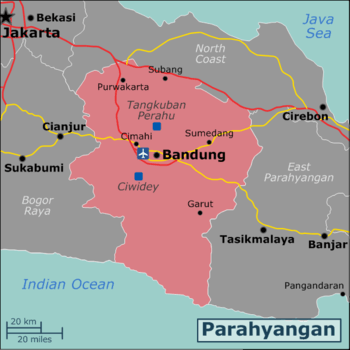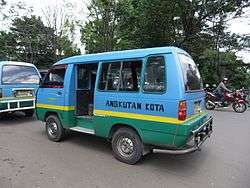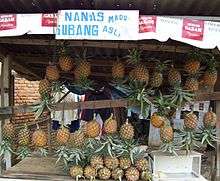Parahyangan
Parahyangan (or Priangan, Preanger) is a mountainous region in Western Java, Indonesia. The region is centred around West Java's provincial capital Bandung.
Cities

- 🌍 Bandung — centre of Sundanese culture, nicknamed 'Paris of Java'.
- 🌍 Cimahi — suburb of Bandung with a large Dutch war cemetery.
- 🌍 Garut — surrounded by volcanoes, known for the volcanic hot spring resorts.
- 🌍 Lembang — mountain town at the foot of the Tangkuban Perahu volcano.
- 🌍 Purwakarta — city along the largest artificial lake of the country.
- 🌍 Subang — in the northern foothills, with a history museum.
- 🌍 Sumedang — another mountain town, known for a specific type of fried tofu.
Other destinations
Understand
The name 'Parahyangan' is Sundanese for 'the abode of the gods', as the Sundanese believed that spiritual entities (hyang or gods) resided in the mountain tops. The oldest remaining reference to Parahyangan dates from the 14th century, when it was part of the Sunda Kingdom. After the fall of the kingdom in the 16th century, large parts of Western Java came under the control of the sultanates of Banten and Cirebon and the Mataram Sultanate from Central Java.
Soon after, the colonial powers from Europe came to Java, and the Dutch East India Company (VOC) settled in Batavia (Jakarta). By the early 18th century also the entire Parahyangan region was under Dutch control. A very important development for the hardly accessible region was the construction of the Great Post Road in the early 19th century. The city of Bandung was established at the location where the road crossed the Cikapundung river, and quickly grew to become the most important city in the area (historically, Cianjur and Ciamis had been more important). Also the town of Sumedang developed as a resting place along the Great Post Road, and the Dutch established extensive plantations for coffee, tea, rubber, and other crops in Parahyangan (Preanger in Dutch).
Get in
By plane
The region is served by Husein Sastranegara Airport in Northwest Bandung. There are multiple flights per day to and from Denpasar (Bali), Medan, Pekanbaru, Batam, Palembang, Surabaya, Semarang, and Yogyakarta, and daily flights to and from most other major cities in Indonesia. Multiple daily international flights arrive from Kuala Lumpur and Singapore, and a few per week from Johor Bahru. Much more flights, both domestic and international, arrive at Jakarta's Soekarno-Hatta International Airport. There are frequent direct buses from that airport to Bandung.
By train
The region is traversed by the major southern railway route from Jakarta to Yogyakarta. The busiest station in Parahyangan is the central station of Bandung, with direct trains to destinations throughout Java. Other stations with good train connections beyond the region include Purwakarta and Cimahi.
By bus
The largest bus terminals of the region can be found in Bandung. Leuwi Panjang (South Bandung) bus terminal is served mainly by buses from Greater Jakarta, Banten, and Bogor Raya, while Cicaheum terminal (East Bandung) is served by buses from the eastern parts of West Java province, as well as Central and East Java. There are also highly frequent travel (small shuttle buses) between a range of locations in Jakarta and several places in Bandung. Bus terminals in the other larger towns (Purwakarta, Garut, Subang, and Sumedang) are served mainly by intercity buses from Jakarta (and Bandung).
By car
There are four main roads into the region, of which the most important is the Cipularang toll road that connects Cikampek (and Jakarta) to Bandung. The original route of the Great Post Road as constructed in the early 19th century is still an important road to connect Cianjur in the west via Bandung and Sumedang with Cirebon in the northeast. From the southeast (East Parahyangan), another main road leads to Bandung. Traffic congestion is common on the roads from Jakarta to Bandung, but also on the other main roads this can happen, especially during holidays.
Get around

By car
The road network is extensive, with the city of Bandung at the heart of it. For certain trips within Bandung, and from Bandung to the northeast (to Cimahi and Purwakarta) you can use tolled motorways, while to other destinations smaller regional and local roads need to be used. Roads tend to be severely congested especially in Bandung, but also in the surrounding areas such as Lembang and Cimahi. During weekends and holidays, the roads to tourist attractions, such as the hot springs of Garut, are very busy. Off the main roads, road quality is sometimes poor, and during the rainy season flooding and landslides sometimes result in serious delays.
By train
A railway connects Purwakarta, Cimahi, Bandung, and Cibatu (near Garut). There are only a few trains per day, with most business/executive class trains stopping only at the major stations (such as Bandung's central station). Economy class trains, on the other hand, only call at secondary stations of Bandung, not at the central station. For trips within the Parahyangan region, it is usually easier and quicker to take a bus instead.
By bus
The larger towns and cities are interconnected by a network of buses, with Bandung being a transport hub for the region. Within the city of Bandung and in its immediate surroundings it is easy to get around using a dense network of angkot (public minivans). To get to smaller towns and more remote areas you can take an elf (minibuses on routes between smaller towns, such as from Bandung via Ciater to Subang). As traffic congestion is common in Bandung, journey times of buses are hard to estimate. Especially on weekends and during holidays, also the buses to Garut (via the Nagreg mountain pass) experience serious delays.
By taxi
In Bandung and its surroundings, taxis are widely available. Taxi companies Blue Bird Group and AA Taksi are known to be reliable (using the taxi meter). In the other parts of the region, taxis are more limited. However, in all towns and villages you can rent an ojek (motorcycle taxi), which are usually available at all major street corners. Another transport option in some places, including the southern part of the city of Bandung, is the becak (bicycle rickshaw).
See
Volcanoes

There are about ten active volcanoes in the Parahyangan region. All of the volcanoes can be climbed. Two of the most popular mountains for trekking include Mount Papandayan and Mount Guntur, both near Garut. But the volcanoes can also be enjoyed without having to hike up the mountain. A popular tourist attraction is the Tangkuban Perahu volcano near Lembang, which is sometimes dubbed a 'drive-in volcano', as you can drive by car or motorbike up to the edge of the crater. On the other side of the Tangkuban Perahu you can find the volcanic hot spring resorts of Ciater. Similarly, also in the surroundings of Garut there are various hot springs.
Another volcano that is easily accessible is the southern crater of the Patuha volcano in Ciwidey. You can go by car or by public transport until near the crater lake (Kawah Putih, white crater), and have to walk just a few hundred metres to enjoy the view (and smell) of the blue-coloured sulphur lake.
Historic sights
There are only few sights in the region from the pre-colonial time, but an exception is Candi Cangkuang, a small 8th century Hindu temple near Garut. Most of the historic sights in the region are Dutch colonial buildings, of which there are plenty especially in Bandung, but also in other towns usually some buildings are remnants of the colonial time, such as railway stations, government buildings, and post offices.
A famous example of colonial architecture is Gedung Sate. The building in Neoclassicist style was built to become a ministry building, but is now the seat of the governor of West Java. Another example is Gedung Merdeka (Independence Building), that was built in Art Deco style and used as a social gathering place for the Dutch community of Bandung. After Indonesian independence, Indonesia's first president Soekarno used the building in 1955 as the venue for the Bandung Conference, an international meeting of the Non-Aligned Movement. Other buildings from the colonial era in Bandung include the Bandung Cathedral, the campus buildings of the ITB university, many residential dwellings, hotels along the Great Post Road, and many more. In Lembang you can visit the Bosscha Observatory, built in 1923 for the Association of Dutch East Indies Astronomers.
Museums
The Gedung Merdeka in Central Bandung now houses a museum on the Bandung Conference of 1955. Other museums in Bandung include the Geological Museum, the Sri Baduga Maharaja on the pre-colonial history of West Java, and a museum on the history of postal communication in Indonesia. The town of Subang has a museum on local history, and Sumedang has a museum on traditional Sundanese weaponry.
Do
.jpg)
A favourite activity for tourists is to visit a traditional music and dance performance. In East Bandung, you can visit Saung Angklung Udjo, where the traditional Sundanese musical instrument 'angklung' is made, children learn to play it, and performances are given using the angklung instrument and combined with traditional dance.
In South Bandung, Trans Studio Bandung is one of the largest indoor theme parks in the world, with twenty rides.
Eat
The traditional food from the region, Sundanese food, is ubiquitous and can be found everywhere from major hotels to roadside food stalls. The food is characterised by fresh (often raw) vegetables, sambal terasi (chilli sauce with shrimp paste), and fried tofu and tempeh. The city of Bandung is known as a destination for culinary tourism, not only for Sundanese food but for cuisines from throughout the Indonesian archipelago and beyond. In the major shopping malls, you can also find international food, such as Chinese, Japanese, or Italian.
In traditional Sundanese restaurants, it is common to sit on a bamboo mat on the floor and eat with your hands. A small bowl of water is provided to clean your hands before eating. A well-known place to eat Sundanese food in traditional style is the Puncrut area along the hillside in Northwest Bandung, but Sundanese restaurants can be found throughout the region.
A typical Sundanese dish is nasi timbel, with steamed rice wrapped in a banana leaf, served with fried or grilled chicken, duck, or pigeon, tofu and tempeh, fresh vegetables, and sambal (chilli sauce). The city of Bandung is also known for soto Bandung (clear beef soup with soybeans) and siomay Bandung (also known as baso tahu, steamed dumplings served with spicy peanut sauce).

The city of Sumedang is known for its specific style of fried tofu, tahu Sumedang. Purwakarta's most famous dish is sate maranggi, a mutton or beef satay seasoned with among others soy sauce, ginger, and coriander, and served only with sliced onion and tomatoes and without sauce. Garut's contribution is the dodol snack, a sticky sweet made of coconut milk, jaggery, and glutinous rice flour. The smaller mountain towns all have their own specialty when it comes to food production, with Lembang known for the fresh cow milk (during the colonial time the Dutch found Lembang to have a good climate), Ciater and the Subang region for pineapples, and Ciwidey for strawberries.
Drink
In Bandung, especially the northern part of the city, there are various cafés, bars, and nightclubs. In the remainder of the region cafés that sell alcoholic drinks are less common, but usually you can buy Bintang beer at least in the hotels and resorts.
Stay safe
Be aware that there are several active volcanoes in the area. Make sure to be informed about the latest situation on eruptions and volcanic activity from the Indonesian authorities when you want to climb a volcano.
Keep also in mind that traffic is very busy and chaotic. If you are not used to driving in Indonesia, it is better to use public transport or to hire a car with a driver rather than attempting to drive by yourself.
Go next
- East Parahyangan — more volcanoes, as well as popular beach resorts on the Indian Ocean coast.
- North Coast of West Java — beaches along the Java Sea coast and the 'city of shrimps' Cirebon.
- Bogor Raya — world-class botanical gardens and two national parks.